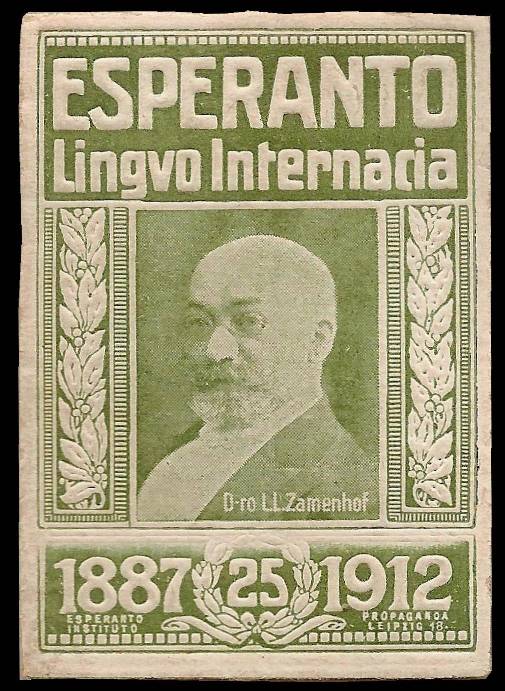
Esperanto poster stamp, L L Zamenhof,
issued by the Esperanto Institute in Leipzig,
25th anniversary of the movement, 1912
Dr. Zamenhof was born in in
Bialystok, Poland, in 1859, and when he was growing up he was very disturbed by the conflicts among the
many ethnic groups in the area - Poles, Jews, Belarussians, Russians, etc. It seemed to him that their many languages were a source
of the conflict, and if everyone shared a neutral language there would be less misunderstanding and strife. He began
designing such a language in his teens, and completed the project by the time he was nineteen, but it was nine years later, 1887,
before he could publish it. His goal was to make it easy to learn, with simple, consistent grammar, syntax, and pronunciation.
Its roots are in Slavic, Germanic and Romance languages, and any American with a year of high school French or Spanish
will recognize many of the words at once. Its proponents claim one can become fluent in it with just a few months of study.
In its early years, use of the language was confined to eastern Europe, and mainly in correspondence, but as it spread,
it gained popularity in speech as well, and an international organization formed to promote its use.
It is a credit to Zamenhof's genius that his language caught on, and developed a dedicated following. It was not the only
artifical language invented during that time, but it is the only one that has lasted.
Based on the material I have collected, it seems to me that its height
was from about 1910 to 1940. That is the period when it was used most often not just on material promoting Esperanto,
but also on publicity for large fairs and celebrations that were advertised in multiple languages.
While Esperanto has never been given official status in international diplomacy, it WAS once declared the official language
of a "country," albeit a *very* tiny one, and yes, there were stamps, in Esperanto - click on "Rose Island" in the column on the left for the full story.
Today Esperanto is by far the most popular constructed language, with at least 100,000 speakers world-wide. Some estimate
the number of Esperantists as high as several million. There are Esperanto clubs, newsletters, conventions, museums, and libraries.
UC Berkeley offers an Esperanto course occasionally.
Google's translation engine even recognizes Esperanto!


